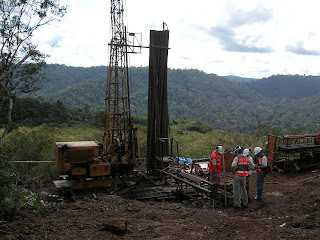Day 4: Looking into the world's largest open-pit mine
Monday, 30 April 2007. First, we went drove to the overlook point of the 4NE mine. This is the largest mine and has been in continual operation since commercial mining began in 1984. The scale of this one pit alone is impressive. It's sort of like standing on the edge of a man-made Grand Canyon. Okay, it's not quite that big, but still, considering it is basically a hole dug in the ground, it is large.

Next we received hard hats and safety vests. Safety is of paramount concern in the mine. The mine trucks and digging machines make normal cars look like toys by comparison. Ever seen pictures of Bigfoot at a monster truck rally? Well, these mine trucks could roll over Bigfoot like Bigfoot rolls over normal cars. So staying out of their way and avoiding areas where they are blasting is goal #1.
After gawking at the N4E pit for a while, we moved onto the smaller N4W central pit. Since it is not actively being mined at the moment, it's a lot safer for us to scamper about. Spent rest of morning exploring highly dipping strata along western edge of pit.
After lunch at mine cafeteria (courtesy CVRD), we drove to several sites on a canga-covered plateau. "Canga" is a Brazilian turn for a type of deeply-weathered surface layer. As high volumes of rainwater percolate down into the ground, mobile elements are gradually stripped from upper layers, leaving a leeched cover of deeply weathered material. Anyway, on this particular plateau, Giliberto is overseeing systematic drilling program. The company is having drill cores extracted every 100 meters in a gridded pattern. Although time-consuming and undoubtedly expensive, such an intensive drilling program allows mining geologists and engineers to construct a highly detailed view of the subsurface rock strata and allows them to focus their efforts on the most worthwhile areas. Late in the afternoon we retired back to the field office to plan for the next day.

View from overlook point of N4E mine, Carajas, Brazil (click image for larger version)
Next we received hard hats and safety vests. Safety is of paramount concern in the mine. The mine trucks and digging machines make normal cars look like toys by comparison. Ever seen pictures of Bigfoot at a monster truck rally? Well, these mine trucks could roll over Bigfoot like Bigfoot rolls over normal cars. So staying out of their way and avoiding areas where they are blasting is goal #1.
After gawking at the N4E pit for a while, we moved onto the smaller N4W central pit. Since it is not actively being mined at the moment, it's a lot safer for us to scamper about. Spent rest of morning exploring highly dipping strata along western edge of pit.
After lunch at mine cafeteria (courtesy CVRD), we drove to several sites on a canga-covered plateau. "Canga" is a Brazilian turn for a type of deeply-weathered surface layer. As high volumes of rainwater percolate down into the ground, mobile elements are gradually stripped from upper layers, leaving a leeched cover of deeply weathered material. Anyway, on this particular plateau, Giliberto is overseeing systematic drilling program. The company is having drill cores extracted every 100 meters in a gridded pattern. Although time-consuming and undoubtedly expensive, such an intensive drilling program allows mining geologists and engineers to construct a highly detailed view of the subsurface rock strata and allows them to focus their efforts on the most worthwhile areas. Late in the afternoon we retired back to the field office to plan for the next day.


